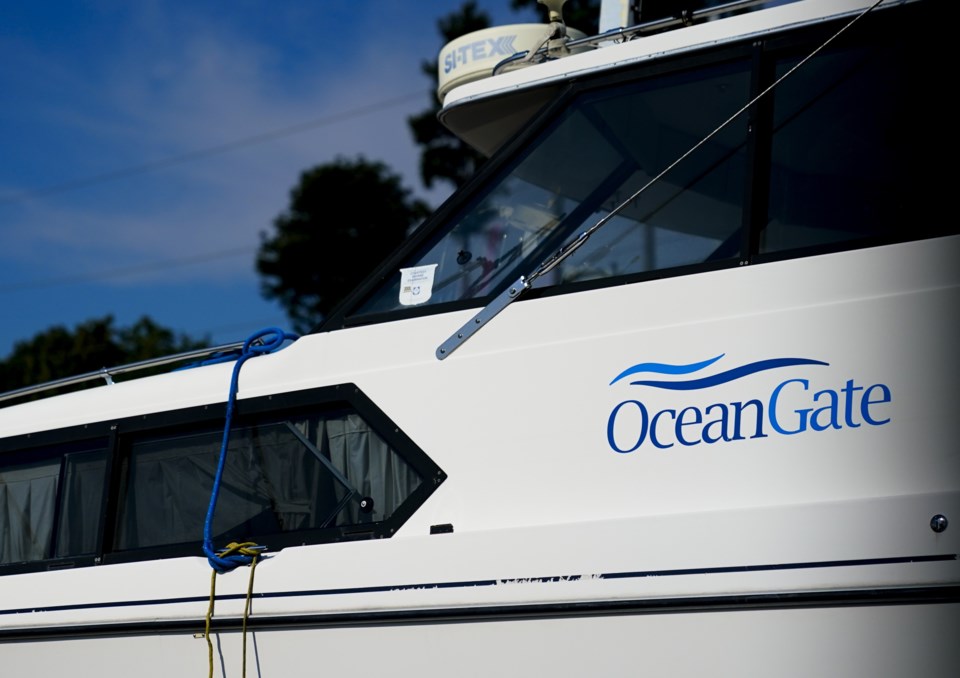BOSTON (AP) — The deadly implosion of the Titan submersible raises questions about whether the vessel exploring the Titanic wreckage was destined for its own disaster because of its unconventional design and its creator’s refusal to submit to safety checks that are standard in the industry.
All five people aboard the Titan died when it was crushed near the world's most famous shipwreck, U.S. Coast Guard Rear Adm. John Mauger said Thursday, bringing an end to a massive multinational search that began Sunday when the vessel first lost contact with its mother ship in the unforgiving North Atlantic.
The Titan, owned and operated by OceanGate Expeditions, began taking people to the Titanic in 2021. It was touted for a design that included a carbon fiber composite hull, an elongated chamber for crew and passengers, and a monitoring system that continually assesses the integrity of the hull — a departure from more traditional constructions that included spherical hulls and all-titanium construction.
The cabin where people sit in most submersibles is spherical, said Chris Roman, a professor at the University of Rhode Island’s Graduate School of Oceanography, who had not been on the Titan but has made several deep dives in Alvin, a submersible operated by the Woods Hole Oceanographic Institute in Massachusetts.
The sphere is “the perfect shape,” because water pressure is exerted equally on all areas.
“There’s no stress hotspots and there's no obvious place where stress is higher than any other place,” he said.
By comparison, the chamber in the Titan had a larger, more elongated tube shape, he said. To his knowledge, the vessel was one of the largest submersibles in operation.
The 22-foot long (6.7-meter long), 23,000-pound (10,432-kilogram) Titan’s larger internal volume — while still cramped with a maximum of five seated people — meant it was subjected to more external pressure.
Elongating the cabin space in a submersible increases pressure loads in the midsections, which increases fatigue and delamination loads, said Jasper Graham-Jones, an associate professor of mechanical and marine engineering at the University of Plymouth in the United Kingdom.
Fatigue, he said, is like bending a wire back and forth until it breaks. Delamination, he said, is like splitting wood down the grain, which is easier than chopping across the grain.
Furthermore, the Titan's hull had been subjected to repeated stress over the course of about two dozen previous dives, Graham-Jones said.
Each trip would put tiny cracks in structure, he said. “This might be small and undetectable to start but would soon become critical and produce rapid and uncontrollable growth."
OceanGate promoted the Titan's carbon fiber and titanium construction as “lighter in weight and more efficient to mobilize than other deep diving submersible” on its website. It also said the vessel was designed to dive four kilometers (2.4 miles) “with a comfortable safety margin,” according to documents filed in April with a U.S. District Court in Virginia that oversees Titanic matters.
“The strength, weight and buoyancy that we get out of it exceeds really any other material out there,” OceanGate director of engineering Tony Nissen told KOMO-TV in 2018.
But carbon composites have limited life when subject to excessive loads or poor design which leads to stress concentrations, Graham-Jones said.
“Yes, composites are extremely tough. Yes, composites are extremely long lasting. But we do have issues with composites and the fact that composites fail in slightly different ways than other materials,” he said.
Most submersibles are all titanium, Graham-Jones said.
Furthermore, documents show that OceanGate was warned that the way the experimental vessel was developed could pose catastrophic safety problems.
David Lochridge, OceanGate’s then-director of marine operations, said in a 2018 lawsuit that the company’s testing and certification was insufficient and would “subject passengers to potential extreme danger in an experimental submersible.”
The Marine Technology Society, an organization of ocean engineers, technologists, policymakers and educators, also expressed concern in a 2018 letter to Stockton Rush, OceanGate’s chief executive who died in the latest mission. The society said it was critical that the company subject Titan prototype to tests overseen by an expert third party.
The society was worried that “the current experimental approach adopted by OceanGate could result in negative outcomes (from minor to catastrophic) that would have serious consequences for everyone in the industry,” The New York Times reported.
Though Graham-Jones said it's standard procedure in engineering to seek outside expertise the ensure that vessels conform to the highest industry standards, OceanGate often eschewed that — relying instead on its own testing protocols and standards.
In a 2019 company blog post, OceanGate criticized the third-party certification process as one that is time-consuming and stifles innovation.
“Bringing an outside entity up to speed on every innovation before it is put into real-world testing is anathema to rapid innovation," the post said.
Famed undersea explorer Robert Ballard, who first located the Titanic wreckage in 1985, called the lack of outside certification and classification a “smoking gun" in the vessel's failure.
“We’ve made thousands and thousands and thousands of dives with other countries as well to these depths and have never had an incident,” he said Friday on ABC’s “Good Morning America."
“Titanic” director James Cameron, who has made multiple descents to the Titanic, said there are several possible reasons for the submersible's destruction, but said the most likely is a failure of the hull.
“The question is, was it the primary failure, or a secondary failure from something else happening?" he told “Good Morning America" Friday. "And I’m putting my money on the composite because you don’t use composites for vessels that are seeing external pressure."
Mark Pratt, The Associated Press




